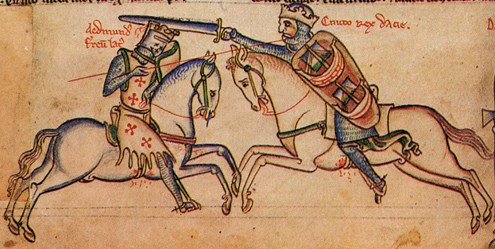
Earl Godwine is one of the delicious mysteries of the eleventh century. Having risen to one of Saxon England’s most powerful positions, as well as father to both a queen and a king, it is a wonder that his origins are so confused.
The most popular story—as written in the Icelandic Knytlinga Saga (written in the 1250s)—is that he was a shepherd, or son of a ceorl, who discovered a Viking Earl wandering lost in the forest after a great battle. Earl Ulf offered him a gold ring as payment for escort back to his ship, but Godwine decided to forgo the reward and help the Viking as a favor, hoping to earn his fortune in the Earl’s service. Somewhere along the way he caught the attention of King Canute, who made use of him and eventually raised Godwine up as Earl of Wessex.
Although this story says a lot about Godwine’s abilities, usefulness, or persuasiveness, I can’t help but think it highly unlikely that Canute would notice him at all if he was only the son of a ceorl—much less raise him up to the highest rank in the land after king.
However, there is another explanation that makes more sense. In some early documents, it is said that Godwine’s father was named Wulfnoth Cild, who was a Thegn in the service of King Aethelred the Unready. Wulfnoth had command of the Saxon Fleet, and in 1009 he was accused of some unspecified treason. Because of this, Wulfnoth deserted with 20 ships, and resorted to piracy on the Sussex coast. The king sent his uncle Bithric after him with the rest of the Saxon navy, but the ships foundered in a great storm and Wulfnoth finished them off by burning the fleet. The destruction of the King’s ships left the way open for that year’s Viking invasion, or, as some suggested, Wulfnoth joined Svein Forkbeard as part of his revenge.
Either way, Wulfnoth was in disgrace. But could it be possible that King Canute raised up the son in recognition of the father’s aid? If Wulfnoth was a Thegn, then Godwine’s advancement would seem much less incredible. No one knows for sure.
Another explanation, less colorful but very sensible, states that Godwine was mentioned in the Aetheling Athelstan’s will (the son of Aethelred the Unready). Aethelstan is said to have granted him his father’s confiscated estate in 1014. On Aethelstan’s death, Godwine is said to have transferred his allegiance to Edmund Ironside, and fought with him against young Canute. He supposedly stayed with Edmund until the end, after which he swore allegiance to Canute along with the rest of Edmund’s supporters. It is said that Canute favored Godwine because he rewarded those who proved loyal to his predecessor.
This latter story promotes Godwine as a warrior rather than a politician, but I tend to favor the former version of the great Earl of Wessex. If you are interested in a further discussion of Godwine’s origins, you can find a long dissertation in the Vol. 1 Appendix of Edward A Freeman’s “History of the Norman Conquest of England”. Or, you can read more in my historical novel GODWINE KINGMAKER.